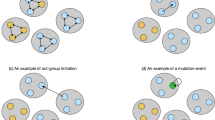Abstract
The question of how cooperative groups can evolve and be maintained is fundamental to understanding the evolution of social behaviour in general, and the major transitions in particular. Here, we show how selection on an individual trait for group size preference can increase variance in fitness at the group-level, thereby leading to an increase in cooperation through stronger group selection. We are thus able to show conditions under which a population can evolve from an initial state with low cooperation and only weak group selection, to one where group selection is a highly effective force.
Access this chapter
Tax calculation will be finalised at checkout
Purchases are for personal use only
Preview
Unable to display preview. Download preview PDF.
Similar content being viewed by others
References
Stewart, J.: Evolutionary transitions and artificial life. Artificial Life 3(2), 101–120 (1997)
Nitschke, G.: Emergence of cooperation: State of the art. Artificial Life 11, 367–396 (2005)
Hammerstein, P.: Genetic and Cultural Evolution of Cooperation. MIT Press, Cambridge (2003)
West, S.A., Griffin, A.S., Gardner, A.: Evolutionary explanations for cooperation. Current Biology 17(16), R661–R672 (2007)
Maynard Smith, J., Szathmáry, E.: Major Transitions in Evolution. Spektrum (1995)
Michod, R.E.: Darwinian Dynamics: Evolutionary Transitions in Fitness and Individuality. Princeton University Press, Princeton (1999)
Bedau, M.A.: Artificial life: organization, adaptation, and complexity from the bottom up. Trends in Cognitive Science 7, 505–512 (2003)
Wilson, D.S., Sober, E.: Reintroducing group selection to the human behavioral sciences. Behavioral and Brain Sciences 17(4), 585–654 (1994)
Maynard Smith, J.: Group selection. Quarterly Review of Biology 51, 277–283 (1976)
Wilson, D.S.: Altruism in mendelian populations derived from sibling groups: The Haystack model revisited. Evolution 41(5), 1059–1070 (1987)
Wilson, D.S., Colwell, R.K.: Evolution of sex ratio in structured demes. Evolution 35(5), 882–897 (1981)
Flemming, H.C., Neu, T.R., Wozniak, D.J.: The EPS matrix: The ”House of Biofilm Cells”. Journal of Bacteriology 189(22), 7945–7947 (2007)
Powers, S.T., Penn, A.S., Watson, R.A.: Individual selection for cooperative group formation. In: Almeida e Costa, F., Rocha, L.M., Costa, E., Harvey, I., Coutinho, A. (eds.) ECAL 2007. LNCS (LNAI), vol. 4648, pp. 585–594. Springer, Heidelberg (2007)
Avilés, L.: Cooperation and non-linear dynamics: An ecological perspective on the evolution of sociality. Evolutionary Ecology Research 1, 459–477 (1999)
Maynard Smith, J.: Group selection and kin selection. Nature 201, 1145–1147 (1964)
Doebeli, M., Hauert, C.: Models of cooperation based on the prisoner’s dilemma and the snowdrift game. Ecology Letters 8(7), 748–766 (2005)
Gore, J., Youk, H., van Oudenaarden, A.: Snowdrift game dynamics and facultative cheating in yeast. Nature 459, 253–256 (2009)
Powers, S.T., Penn, A.S., Watson, R.A.: The efficacy of group selection is increased by coexistence dynamics within groups. In: Proceedings of ALife XI, pp. 498–505. MIT Press, Cambridge (2008)
Author information
Authors and Affiliations
Editor information
Editors and Affiliations
Rights and permissions
Copyright information
© 2011 Springer-Verlag Berlin Heidelberg
About this paper
Cite this paper
Powers, S.T., Watson, R.A. (2011). Evolution of Individual Group Size Preference Can Increase Group-Level Selection and Cooperation. In: Kampis, G., Karsai, I., Szathmáry, E. (eds) Advances in Artificial Life. Darwin Meets von Neumann. ECAL 2009. Lecture Notes in Computer Science(), vol 5778. Springer, Berlin, Heidelberg. https://doi.org/10.1007/978-3-642-21314-4_7
Download citation
DOI: https://doi.org/10.1007/978-3-642-21314-4_7
Publisher Name: Springer, Berlin, Heidelberg
Print ISBN: 978-3-642-21313-7
Online ISBN: 978-3-642-21314-4
eBook Packages: Computer ScienceComputer Science (R0)




